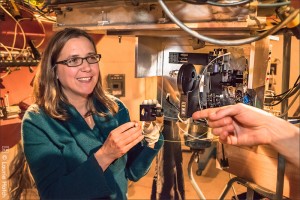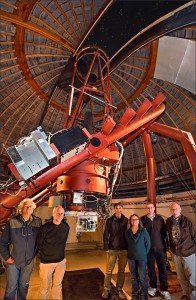TORONTO, ON (March 19th 2015) – On PI Day, March 14th, a team of astronomers expanded the search for extraterrestrial intelligence into a new realm when they achieved first-light with a ground-breaking instrument. While most searches have been conducted with radio telescopes, the instrument, called NIROSETI, is the first capable of detecting extremely short, extremely bright pulses of infrared light.
“Infrared light is an excellent means of interstellar communication,” said Shelley Wright, an Assistant Professor of Physics at the University of California, San Diego, who led the development of the new instrument while at the University of Toronto’s Dunlap Institute for Astronomy & Astrophysics. Interstellar gas and dust is almost transparent to near infrared, so these signals can be seen from great distances.
NIROSETI looks for short pulses based on the thinking that an advanced alien civilization attempting to communicate with us would send pulses rather than a continuous signal because an infrared laser can outshine the Sun if the signal lasts only a billionth of a second.
According to Wright, the idea dates back decades. Charles Townes, the late UC Berkeley scientist whose contributions to the development of lasers led to a Nobel Prize, suggested the idea in a paper published in 1961.
Scientists have searched the heavens for radio signals for more than 50 years and expanded their search to the optical realm more than a decade ago. But instruments capable of capturing pulses of infrared light have only recently become feasible.
“We had to wait for technology to catch up,” Wright said. “I spent eight years waiting and watching as new technology emerged.”
Then, three years ago while at the Dunlap Institute, Wright purchased newly available detectors. She and Dunlap Fellow Jérome Maire—who played a key role in developing the new instrument—tested the detectors and found that they could turn the concept into reality. “It was exciting,” said Maire, “to solve the technological challenge of building the first instrument capable of detecting an infrared signal a billionth of a second long.”
NIROSETI has been installed at the University of California’s Lick Observatory on Mt. Hamilton east of San Jose. The observatory has been the site of several previous SETI searches including an optical instrument which Wright built as an undergraduate student at UC Santa Cruz under the direction of Remington Stone, the director of operations at Lick at that time. Dan Werthimer and Richard Treffers of UC Berkeley designed that first optical instrument. All three are playing critical roles in the new search.
NIROSETI could uncover new information about the physical Universe as well. “This is the first time Earthlings have looked at the Universe at infrared wavelengths with nanosecond time scales,” Werthimer said. “The instrument could discover new astrophysical phenomena, or perhaps answer the question of whether we are alone.”
The group also includes SETI pioneer Frank Drake of the SETI Institute and UC Santa Cruz who serves as a senior advisor to both past and future projects and is an active observer at the telescope.
Drake pointed out several additional advantages to a search in this new realm. “The signals are so strong that we only need a small telescope to receive them. Smaller telescopes can offer more observational time, and that is good because we need to search many stars for a chance of success.” he said. The receivers are also much more affordable that those used on radio telescopes.
“There is only one downside: the extraterrestrials would need to be transmitting their signals in our direction,” Drake said, though he sees a positive side to that limitation. “If we get a signal from someone who’s aiming for us, it could mean there’s altruism in the universe. I like that idea. If they want to be friendly, that’s who we will find.”
The NIROSETI team also includes Geoffrey Marcy and Andrew Siemion from UC Berkeley; Patrick Dorval, a University of Toronto undergraduate, and Elliot Meyer, a University of Toronto graduate student. Shelley Wright is also a member of the Center for Astrophysics and Space Sciences at UC San Diego. Richard Treffers is now at Starman Systems.
Funding for the project comes from the generous support of Bill and Susan Bloomfield.
-30-
Image captions:
Image 1: Prof. Shelley Wright, University of California, San Diego, installing NIROSETI on the Anna B. Nickel 40-inch reflector at the University of California’s Lick Observatory. Wright and her team designed and built NIROSETI while at the Dunlap Institute for Astronomy & Astrophysics, University of Toronto. Image credit: © 2015 Laurie Hatch
Image 2: The NIROSETI instrument mounted on the Anna B. Nickel 40-inch reflector at the University of California’s Lick Observatory. (l. to r.) Remington Stone, Dan Werthimer, Jérome Maire, Shelley Wright, Patrick Dorval, and Richard Treffers. Also on the team but not shown here are Frank Drake, Geoffrey Marcy, and Andrew Siemion. Wright and her team designed and built NIROSETI while at the Dunlap Institute for Astronomy & Astrophysics, University of Toronto. Image credit: © 2015 Laurie Hatch
For higher-resolution/larger images: http://www.lauriehatch.com/GalleryMain.asp?GalleryID=134713&AKey=6Q457TBG
Public information contacts:
Chris Sasaki
Communications Coordinator
Dunlap Institute for Astronomy & Astrophysics
University of Toronto
e: media@dunlap.utoronto.ca
p: 416-978-6613
w: http://dunlap.utoronto.ca
Susan Brown
University of California, San Diego
e: sdbrown@ucsd.edu
w: http://physicalsciences.ucsd.edu
p: 858-246-0161
The Dunlap Institute for Astronomy & Astrophysics, University of Toronto, continues the legacy of the David Dunlap Observatory by developing innovative astronomical instrumentation, including for the largest, most advanced telescopes in the world; by training the next generation of astronomers; and by fostering public engagement in science. The research of its faculty and postdoctoral fellows includes the discovery and characterization of exoplanets, the formation of stars, galactic nuclei, the evolution and nature of galaxies, the early Universe and Large Scale Structure, and the Search for Extra-terrestrial Intelligence (SETI). Together, the Dunlap Institute, the University of Toronto’s Department of Astronomy & Astrophysics, and the Canadian Institute for Theoretical Astrophysics comprise the leading centre for astronomical research in Canada at the country’s leading research university.
###


